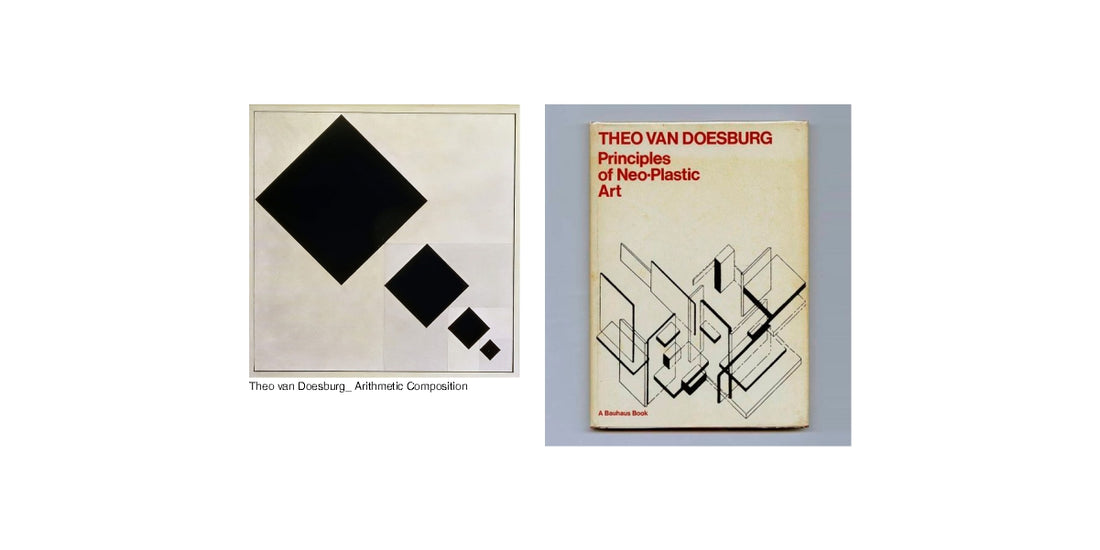Hi! I'm happy to find you here. I would like to tell you more about my fascination for working with geometric surfaces. Why I choose to work with these shapes and how I manipulate them into wearable garments.
But first I'll tell you a little bit about how it all started. As a child my mother took me to our local museum 'De Lakenhal' and there it was: a room full of art made by 'De Stijl' members, dada artists and Bauhaus. A whole new world opened up for me! I felt in a parallel universe, a world that felt like coming home and I felt understood. It was okay to see things from a different perspective. There were more! Having a different view of the world can be challenging, but at the same time it opens up new possibilities.
Perhaps you are not familiar with the De Stijl art movement? No problem, I will tell you more about this. It all started in 1917, in Leiden, the city where I also happened to grow up. A new art magazine was founded here, 'De Stijl'. It started as a project by artist and publicist Theo van Doesburg. He is actually a bit of a self-proclaimed founder, editor and propagandist of De Stijl.
The most important members of De Stijl were Theo van Doesburg, Piet Mondriaan, Vilmos Huszár, Bart van der Leck, Antony Kok, J.J.P. Oud, Jan Wils, Robert van 't Hoff, Gerrit Rietveld and Georges Vantongerloo. The members of De Stijl strove for a radical reform of art as it had been known until then. Its development went hand in hand with the technical, scientific and social changes in the world. The main points for this reform were the use of a minimum of colours (primary colours, combined with black, white and grey) and a design that was as simple as possible (preferably according to the orthogonal system). Although De Stijl magazine never sold more than 300 copies, it had a major influence on art in the Netherlands, in Europe and abroad. Internationally, De Stijl is better known as neoplasticism or new plasticism, where it played a central role in the European avant-garde from the 1930s. At about the same time as De Stijl, more like-minded initiatives emerged in Europe, such as Bauhaus and Dada. Artists from all these movements regularly worked and discussed together.
The most important thing for De Stijl was actually the search for a universal art that would change the world. It called for a new image and a new world. A utopian worldview in which architecture, visual arts, dance, literature and music merged and in which all disciplines were connected. It seems to me enormously inspiring to have lived in those artists' circles at that time. In fact, I sometimes like to think of them as them being a bit like the punks of their time, with their new music, art and graphics.
The core of De Stijl was actually the search for a timeless design language. And it is precisely this timelessness and their abstract design that inspires me. No ornaments or lines that refer to a specific historical era. Abstract and concrete ('Art Concrete', also a beautiful movement and 'invention' by Theo van Doesburg). This abstract approach gives me the space to work as freely as possible on the development of new forms. No frame of reference, no trends or other fuss, but an independent form.
The funny thing is that in my work process is actually the other way around than De Stijl. Where De Stijl tried to further abstract conventional subjects until only geometric motifs remained, my starting point is precisely the abstract form in order to arrive at a wearable piece of clothing. Which in the end sometimes don't look simple and abstract at all.
When I start designing, I predetermine an arbitrary geometric shape. I may start with a piece of fabric that I happen to have lying around, or I just randomly cut a piece from a roll of fabric. With these pieces of fabric I start modeling on a mannequin. It is a very intuitive process in which I investigate how I can arrive at a new shape by means of draping and folding techniques with the simplest possible line. When I've discovered a new pleat or construction, I look at a moulage doll to see how this shape best fits the body. I enlarge or reduce the shape and look for applications on the mannequin. It is a constant balancing act between form, construction and technique, taking into account the technical possibilities, challenges and the properties of the yarn and knitting techniques. During the process I put the moulage on to feel how it works, how it fits, can you put it on easily, can you move around in it. In the end I make a moulage model entirely in a tricot fabric. I will analyze this model and work out all the technical details.
You could say that I work more sculptural with the only restriction being that you have to be able to wear it. Freedom of movement is always important to me. You must be able to move freely in my designs and it must be easy to maintain. I myself am a mother of two daughters, so I know how nice it is to wear comfortable clothes, but I want to look the way I feel. That's why in my designs, I always look for a kind of sturdiness mixed with elegance.
De Stijl's work is pragmatic and may seem robust, each line has been preceded by a deep thought process before being translated into reality. And let's be honest, the De Stijl movement were actualy the punks of their time. They were way ahead with their ideas!

